
By Raul Angulo
Anytime you see a sign or placard with a fire helmet or a pickhead ax, you immediately know it stands for the fire department. These two iconic symbols are recognized around the world.
They symbolize the service of our profession and are also symbols of pride, courage, strength, and honor. That is why either or both of these pieces of equipment are incorporated into department insignias as well as collected, mounted on plaques, and presented at promotional and retirement ceremonies. The ax in particular is a tool for cutting, breaching, and demolishing—and who doesn’t enjoy breaking things?
There are probably few organizations steeped in tradition more than the Chicago (IL) Fire Department. After all, it was the last fire department to give up hip boots. But Chicago Firefighter Mitchell Huner realized many of the tools he used on the job were simply adopted by the fire service but not necessarily designed for the specific fireground assignment. For example, the standard flathead ax, commonly used with the irons, was a chopping blade. It was never meant to be a striking tool, so he set out to build the perfect solution.
Established in 2016, Fire Maul Tools is a firefighter-owned company that was born out of the need for better designed tools for the fireground. Its mission statement was to analyze and test every aspect of the job and design tools to complete the mission, not develop techniques or tactics to overcome the shortcomings in the tools the fire service has inherited—make better tools and then perfect the tactics to use them.
In addition to serving firefighters, the company also builds forcible entry tools for law enforcement and military tactical teams worldwide by providing innovative tools that were designed and engineered for what they’re supposed to do—specifically, breaching doors for entry. In addition to looking for the best innovations in the field, the company also has a passion for bringing firefighter tool manufacturing back to the United States. With the motto of “Do the Hard Things,” every aspect of these tools is designed for the firefighter and not just another adopted tool that is simply “good enough.”

1 The Fire Maul tools (L to R): 8-lb. Reaper, 8-lb. Mauler, 10-lb. TSR Fire Maul, 11-lb. 26-inch TSR Halligan, FMT Lanyard Strap. (Photos by author unless otherwise noted.)

2 The Mauler (L) is an 8-lb. version of the 10-lb. Fire Maul (R). Both heads have wide halligan notches for marrying most halligan bars on the market.
The TSR Fire Maul
The original Fire Maul was launched in 2017. It was a 10-pound maul that was half maul and half ax to perform two of the critical tasks for truck work: cutting and striking. It came with a wooden American hickory handle for strength. The cutting side was a wedge-shape blade to prevent it from sticking in wooden roofs—a common problem with traditional fire axes.
The Fire Maul wasn’t the first ax designed to combine multiple features for various uses. The TNT Denver tool is a popular 5 in 1 hand tool that has an ax blade for chopping, a sledgehammer for striking, a D-handle within the head with a fiberglass handle that serves as a pike pole for pushing and pulling walls and ceilings, a flat tip at the end instead of a pike for prying, and a head that could also be used as a ram. This multipurpose hand tool has its uses for lightweight and medium truck work applications but might not be the tool of choice for heavy rescue, the irons, and commercial door forcible entry situations. Like a Swiss Army knife, it is convenient, has its uses, and can get the job done in certain applications, but it might not be the tool of choice for a professional carpenter or mechanic. They would choose the heavy tool that was designed specifically for a heavy job.
The current version of the Fire Maul head is designed to centralize the mass where it attaches to the 28-inch composite handle. This provides balance to the head. Though the maul is still a 10-pounder, with the weight of the composite handle, the TSR Fire Maul is actually 12 pounds. The large 2½-inch octagon striking face is designed for increased efficiency and force when delivering blows to the target. On the opposite side of the maul, the wedge-shaped blade extends out 4¼ inches from the handle and curves down 3¾ inches. The wedge-shaped blade flairs out 1¼ inches. In other words, you have a 1¼-inch wedge.
In addition to chopping, cutting, and demolishing, the wedge is also designed to capture the gapping and progress of forcing a commercial door when used with the prying forces of the halligan tool. Four blade grooves keep the wedge set when driving and capturing the gap. The top of the head is flat and raised and has a ramming surface that is 9 inches in length and 2½ inches at its widest point. The halligan notch, one notch on each side of the blade, matches the fork width on both the top and bottom of the Fire Maul tool head. This allows the tool to marry and lock on to most halligans without the need of a strap.
The topside notch is used to horizontally extend your halligan with the Fire Maul for additional leverage to easily force inward- and outward-swinging doors. Depending on the length of your halligan tool and the length of the handle on the Fire Maul, your extended halligan can be anywhere from 52 to approximately 60 inches for increased leverage when prying on inward- or outward-swinging commercial doors. For example, let’s say the TSR Halligan is extended with the 28-inch TSR Fire Maul. If 200 pounds of pressure was applied to the Fire Maul handle, it would increase your mechanical advantage 34:1. The prying torque pressure at the adz against the door jamb would be 6,800 pounds of force!
The Mauler
The Mauler is an 8-pound version of the Fire Maul. The USA Patented Collar Shield system is embedded into the head during assembly and provides more than 3½ inches of overstrike protection. The handle can be composite or wood. The collar shield is especially important for protecting the wooden American hickory handles. The wedge-shaped blade is the same dimensions as the Fire Maul, and the techniques for capturing the gapping and progress with the wedge-shaped blade are the same.
The Mauler and the Reaper handles can be ordered with American hickory or composite handles. Composite handles come in 28-, 32-, and 35-inch lengths and come in two colors, red and black. Custom curved wooden hickory handles come in 28-, 30-, 32-, 34-, and 36-inch lengths. Handle length is measured from the top of the tool head to the handle base.

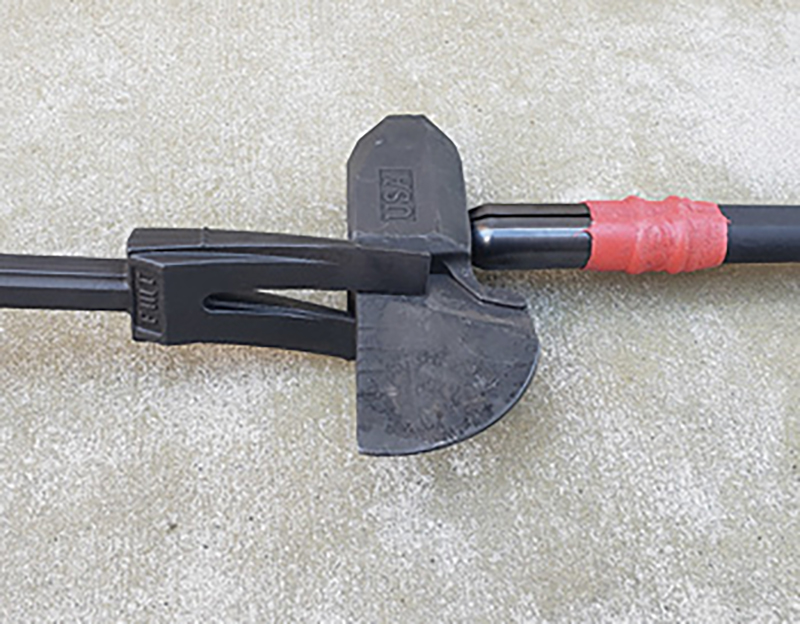
3 4 The halligan forks can marry from the bottom of the Fire Maul blade for storage, carrying, and ramming (photo 3) or from the top of the blade for extending the halligan horizontally for leverage. Note the ramp at the base of the halligan forks (photo 4).
The Reaper
The Reaper is an 8-pound pickhead ax version of the Fire Maul design, but the maul striking surface has been replaced with a four-sided tapered pick. The ax head body has concentrated mass centered over the handle and is 2½ inches in width and 3 inches in height. The wedge-shaped blade is the same design and dimensions of the Fire Maul and the Mauler. From the center of the ax head, the pick end extends 6½ inches. The top of the ax head is flat and from the tip of the pick to the tip of the blade is 12½ inches. Though the Reaper is not a striking tool, it still provides a significant surface area and weight for using it as a ram.
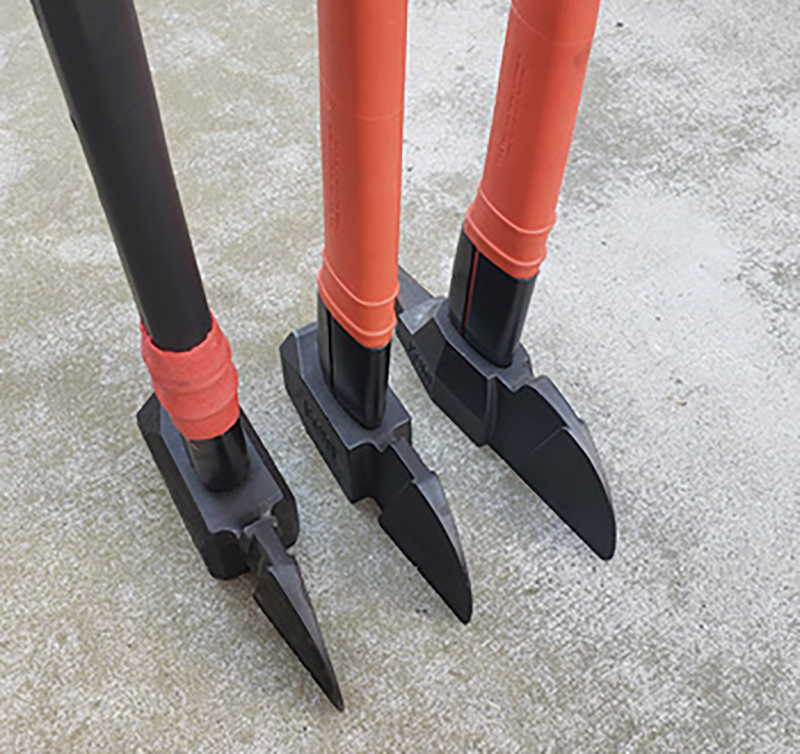
5 The TSR Fire Maul (L), the Mauler (C), and the Reaper (R) all have 1¼-inch wedge-shaped blades with the halligan notches and the four blade grooves to capture the gap progress when driving the tool.
The halligan notches allow the halligan forks to be married to both the blade and the pick side of the tool. You can even extend the halligan bar leverage by marrying to the topside of the pick as well. The wedge-shaped blade will capture the progress and gapping when performing forcible entry.
In vertical ventilation, the wedge-shaped blade tip allows for both low sweeping cuts and deep chops through multilayered roofing material. This blade design is effective in chopping and breaking through tough roofs without the blade becoming stuck in the wood.
The TSR Halligan
The newest edition to the Fire Maul tool family is the TSR (Tactical Strike Ram) Halligan. Redesigned for versatility and better performance, this compact halligan is easier to handle and best suited for forcible entry work in tight spaces. It weighs 11 pounds and is 26 inches in length, which provides a 17:1 mechanical advantage. Longer 30-inch halligans can sometimes be too long for effective use in narrow and dead-end hallways. It is forged from 4140 steel and has a black oxide finish.
Like a mini Fire Maul, this halligan has a 2½-inch octagon fist-shaped striking head. With the concentrated mass and weight plus the striking surface, this halligan can also be used as a striking tool. In fact, two TSR Halligans can work together as a set of irons with one bar for striking and the other using the forks to pry and lever the door. They can leapfrog, capturing the progress and gapping the door.
The adz width has been trimmed down to 1½ inches. The underside length of the adz is 5¼ inches from the handle, and the top length from the blade of the adz to the face of the striking head is 8 inches. An inch and a half adz actually enables an easy full turn of the tool, maximizing the gap when working the door. The adz is also 90 degrees to the shaft to keep the fork end clear from the door. It has a slight downward taper for clearing the door jamb. With 8 inches of striking surface area and the weight of the striking head, this halligan can be used as a ram to shock inward-swinging residential and commercial doors. In fact, one or two forceful punches may be all that is needed to open a residential door.
The forks are 6 inches in length and have a slight curve to them. They are spaced 1 inch apart at the tips. Raised depth markers are etched onto the outside edges of the forks to check progress during the drive. A raised and beveled inside ramp increases the width of the forks at the base. Acting like a wedge, this ramp prevents overdrive and increases the gap when working the door.
Typical spikes are smooth. The TSR Halligan has a hexagonal 4-inch tapered spike for taking a bite and splintering door jambs. The spike has been moved 1 inch below the top surface of the adz to allow initial rolling in either direction. Typically, the halligan is worked away from the spike. Every working edge of the tool is smoothed, tuned, and tapered to easily rock, drive, or roll the halligan into position with less effort.

6 Forged from 4140 steel, the custom TSR Halligan is easier to handle in tight spaces and narrow hallways. It weighs 11 lbs. and is 26 inches in length, providing a 17:1 mechanical advantage. It has 6-inch forks and a raised inside ramp, which increases the width of the forks at the base.

7 The TSR Halligan has a 2½-inch octagon striking face and a weighted head. The hexagonal 4-inch tapered spike is 1 inch below the top surface of the adz to allow initial rolling in either direction. The 1½- × 5¼-inch adz is 90 degrees to the shaft to keep the fork end clear from the door.
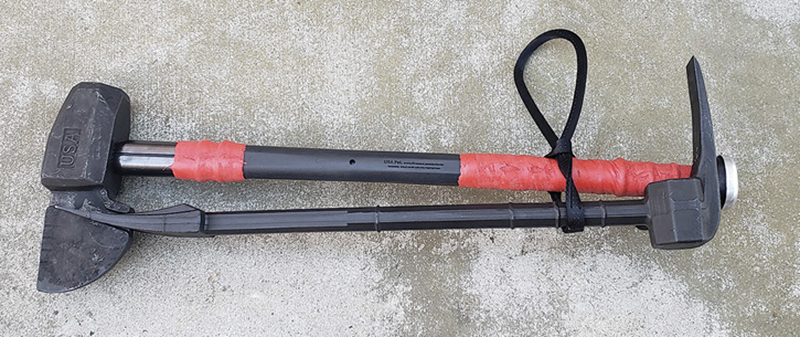
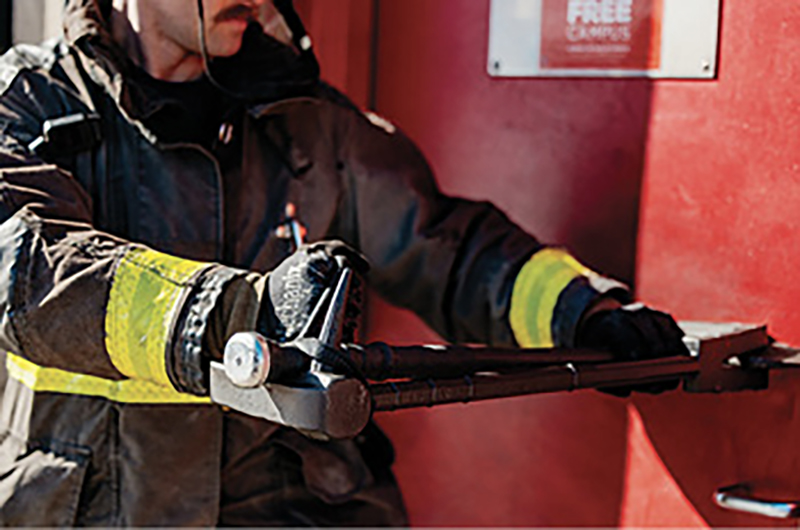
8 9 A girth hitch with the FMT Lanyard Strap secures the two handles together tightly. The large loop can easily accommodate a gloved hand (photo 8). Using the loop allows for a forceful pendulum swing when ramming doors (photo 9, courtesy of Catalyst Rockford).
The TSR Tactical Strike Ram
The Fire Maul TSR is an innovative compact deployable battering ram that easily separates into a set of irons for traditional forcible entry tactics for a total breaching package. Still forged with 4140 steel, the 10-pound Fire Maul was redesigned and improved to specifically fit the 11-pound TSR Halligan to be used exclusively for powerful high- and low-point impacts and for ramming through entry doors with a combined wrecking ball weight of 23 pounds. Its power is only limited by the strength of the firefighter delivering the blows.
The TSR Fire Maul uses a 28-inch Demolish composite sledge-style handle with a patented 3½-inch Colar Shield for overstrike protection and hand placement. It has integrated lacing rings in the grip area and an end cap installed on the bottom of the handle for impact protection when marrying and unmarrying the tools. The wedge-shaped blade for cutting, smashing, and prying, along with the blade grooves to capture the gap and progress in forcing doors, is still included in this version.
Each TSR set comes with the FMT Lanyard Strap that helps locks each tool together while serving as a battering ram. The beefy lanyard keeps the two handles tight, preventing any slippage or heavy shock loads into the hands. Because the forks are wedged into the blade, the striking direction for ramming keeps pushing the forks into the blade. Therefore, you have two tools solidly working as one without any play. Hold the tools with the Fire Maul on top. While one hand grips the neck of the Fire Maul to guide and aim for ramming, the other hand uses the loop at the rear to allow for a forceful pendulum swing. The girth hitch can be easily loosened for separating the tools into irons. Simply turn the Fire Maul around and tap the base of the handle with the end cap on the ground and the forks will release.
Traditional battering rams offer no alternatives when faced with outward-swinging doors. Built for fast breaching entry teams where speed and mobility are paramount, the TSR quickly caught the attention of police SWAT teams and military tactical entry teams. In fact, the demand for the TSR is currently greater there than the demand within the fire service.
All the Fire Maul composite handles can be wrapped with the patented FireWrap® grip system as an option. Unlike hockey tape and paracord, which can absorb chemicals and carcinogenic contamination, FireWrap is an ultra-durable, shock absorbing, nonabsorbent, high-performance grip system that is easy to decon.
TSR Forcible Entry Evolutions
Forcible entry teams usually consist of two firefighters. But because the TSR Fire Maul and the TSR Halligan were designed to work together, they can be tightly married without any play. This allowed Mitch Huner to create forcible entry tactics using these tools that can safely and effectively be performed by a single firefighter. Obviously, it will be easier with two. The tactics are the same for residential and commercial doors. When forcing any inward- or outward-opening door, controlling the door cannot be overemphasized, especially on inward-swinging doors. The sudden release can introduce fresh oxygen into a high-heat, oxygen-deficient atmosphere, which can cause a backdraft, flashover, or smoke explosion. It is the company officer’s responsibility to look for these signs during size-up before giving the forcible entry team the order to execute. A hoseline should be charged and in place.


10 11 Extending the TSR Halligan with the Fire Maul provides 52 inches of extra leverage (photo 10). Applying 200 lbs. of pressure to the Fire Maul handle increases the mechanical advantage 34:1. The prying torque pressure at the adz against the door jamb is 6,800 lbs. of force (photo 11, courtesy of Catalyst Rockford).
Inward-Swinging Doors
If the TSR is to be used as a ram, the target should be at the lock. If the lock is standard, especially on residential wooden doors, it will fail with the first blow. If not, two to three blows should be sufficient if the door is going to fail using this method. Beyond three blows indicates this is a very strong door. The blows should have weakened the seal or loosened the door, so additional ramming blows will not be effective because the energy is being absorbed in the slack. It is time to switch to traditional forcible entry techniques using the TSR as irons.

12 After ramming and capturing a gap at the bottom of the door with your foot, the TSR Fire Maul is placed at a 45-degree angle. The wide blade acts as a wedge to capture the progress. (Photo courtesy of Mitchell Huner.)
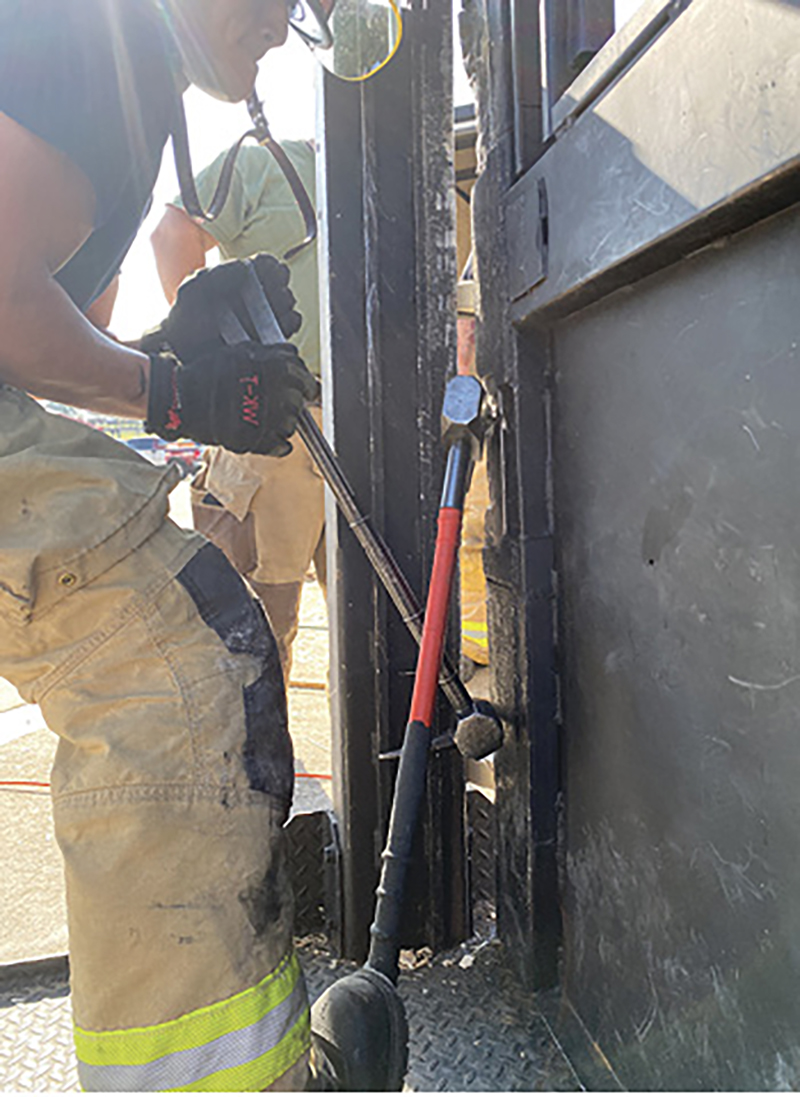
13 Footing the Fire Maul keeps the handle in place and allows for a single firefighter to work the door. The weight of the head, plus gravity, automatically captures the gap and progress. (Photo courtesy of Mitchell Huner.)
- If the TSR is not to be used as a ram—for example, on a heavy commercial door—use the TSR to shock the door low, center, and high to loosen the seal for a gap. Separate the tools and use your foot to push against the base of the door to gain a gap.
- Start low and insert the adz into the gap and start working the door jamb. Since the spike on the TSR Halligan is lower than the adz, you can lever the halligan up and down. Once you have a good purchase point, extend the halligan with the Fire Maul by inserting the forks into the blade. Now you have a 52-inch halligan to increase your leverage with a 34:1 mechanical advantage. 6,800 pounds of torque is being applied to the adz when working the door.
- Separate the tools and insert the Fire Maul blade into the gap to capture your progress. Foot the end of the maul handle at approximately a 45-degree angle. The blade is now a 1¼-inch wedge. As you work the halligan up the door, gravity and the weight of the Fire Maul head will make the head slide into the widening gap by itself. The four blade grooves keep the blade in place without slipping.
- If you want to widen the gap even more with the wedge-shaped blade, you can also strike the Fire Maul using the striking head of the halligan for deeper penetration into the door jamb. Continue working up the door with the halligan using the adz and the forks until it fails. Control the door.
Outward-Swinging Doors
- Set the adz above the lock into the space between the door and the frame. Hold it in place with one hand.
- With your other hand, choke up on the Fire Maul handle below the head. Deliver blows to the halligan to embed the adz into the space. Drive it all the way into the door stop. The tension will hold the halligan horizontally at the 3 and 9 o’clock position.
- Pull the fork end of the halligan away from the door with maximum force to gain leverage. Use additional strikes from the Fire Maul onto the striking head of the halligan for deeper penetration into the frame. Because the adz is beveled, it should not peel the door.
- Once the forks are out about 30 degrees from the door, extend the halligan with the Fire Maul. The blade of the adz should be around and past the width of the door. Using the handle of the Fire Maul, pull the handle away from the door 90 degrees. Torque force will be around 6,800 pounds.
- With the extension, work the adz up and down. Then push the Fire Maul handle beyond 90 degrees. This should finally pop the door open. Control the door.
Raul Angulo is a captain (ret.) of Seattle (WA) Fire Department Ladder Co. 6. He has more than 40 years of fire service experience and is on the Editorial Advisory Board of Fire Apparatus & Emergency Equipment. He is the author of the new textbook Engine Company Fireground Operations 4th Edition (Jones and Bartlett Learning) and has been teaching at FDIC International since 1996.

